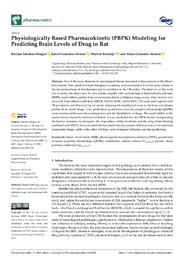Por favor, use este identificador para citar o enlazar este ítem:
https://hdl.handle.net/11000/34721Registro completo de metadatos
| Campo DC | Valor | Lengua/Idioma |
|---|---|---|
| dc.contributor.author | Sánchez-Dengra, Bárbara | - |
| dc.contributor.author | González Álvarez, Isabel | - |
| dc.contributor.author | Bermejo, Marival | - |
| dc.contributor.author | González Álvarez, Marta | - |
| dc.contributor.other | Departamentos de la UMH::Ingeniería | es_ES |
| dc.date.accessioned | 2025-01-16T19:29:58Z | - |
| dc.date.available | 2025-01-16T19:29:58Z | - |
| dc.date.created | 2021-08-03 | - |
| dc.identifier.citation | Pharmaceutics 2021, 13(9), 1402 | es_ES |
| dc.identifier.issn | 1999-4923 | - |
| dc.identifier.uri | https://hdl.handle.net/11000/34721 | - |
| dc.description.abstract | One of the main obstacles in neurological disease treatment is the presence of the blood– brain barrier. New predictive high-throughput screening tools are essential to avoid costly failures in the advanced phases of development and to contribute to the 3 Rs policy. The objective of this work was to jointly develop a new in vitro system coupled with a physiological-based pharmacokinetic (PBPK) model able to predict brain concentration levels of different drugs in rats. Data from in vitro tests with three different cells lines (MDCK, MDCK-MDR1 and hCMEC/D3) were used together with PK parameters and three scaling factors for adjusting the model predictions to the brain and plasma profiles of six model drugs. Later, preliminary quantitative structure–property relationships (QSPRs) were constructed between the scaling factors and the lipophilicity of drugs. The predictability of the model was evaluated by internal validation. It was concluded that the PBPK model, incorporating the barrier resistance to transport, the disposition within the brain and the drug–brain binding combined with MDCK data, provided the best predictions for passive diffusion and carrier-mediated transported drugs, while in the other cell lines, active transport influence can bias predictions. | es_ES |
| dc.format | application/pdf | es_ES |
| dc.format.extent | 15 | es_ES |
| dc.language.iso | eng | es_ES |
| dc.publisher | MDPI | es_ES |
| dc.rights | info:eu-repo/semantics/openAccess | es_ES |
| dc.rights | Attribution-NonCommercial-NoDerivatives 4.0 Internacional | * |
| dc.rights.uri | http://creativecommons.org/licenses/by-nc-nd/4.0/ | * |
| dc.subject | blood−brain barrier (BBB) | es_ES |
| dc.subject | physiologically based pharmacokinetics (PBPK) | es_ES |
| dc.subject | quantitative structure–property relationships (QSPRs) | es_ES |
| dc.subject | distribution volume in brain (Vu,brain) | es_ES |
| dc.subject | plasma−brain partition coefficient (Kpuu,brain) | es_ES |
| dc.subject.other | CDU::6 - Ciencias aplicadas::62 - Ingeniería. Tecnología | es_ES |
| dc.title | Physiologically Based Pharmacokinetic (PBPK) Modeling for Predicting Brain Levels of Drug in Rat | es_ES |
| dc.type | info:eu-repo/semantics/article | es_ES |
| dc.relation.publisherversion | https://doi.org/10.3390/pharmaceutics13091402 | es_ES |

Ver/Abrir:
pharmaceutics-13-01402-v2.pdf
2,62 MB
Adobe PDF
Compartir:
 La licencia se describe como: Atribución-NonComercial-NoDerivada 4.0 Internacional.
La licencia se describe como: Atribución-NonComercial-NoDerivada 4.0 Internacional.
.png)